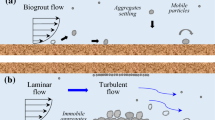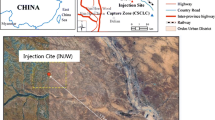Abstract
Biogrouting is a ground improvement technique, which utilizes microorganisms. The numerical simulation of biogrouting is important to ensure efficient operation and to assess the applicability to the target ground. In this study, we compared syringe-scale biogrouting with biogeochemical simulation. Parameters suitable for practical applications were included. The rate constant and half-saturation constant of the reaction rate law in ureolytic bacteria Pararhodobacter sp. strain SO1, obtained from the simulation based on the urease activity test, were 1 × 10−8 mol/mg/s and 0.635 M, respectively. To achieve the same mineral precipitation in measurement and simulation, a setting in which only the calcite precipitated was used. In the sequential simulation of the solidification test, a variation in discharged Ca2+ concentration was reproduced by introducing an “adjustment index”, which considers the microbial biomass contributing to the reaction. Moreover, for the re-injection test, in which microbes were injected again to further improve the biogrout strength, the settings were validated by the sequential simulation followed by predictive simulation on different injection dates. The results indicate that by conducting a biogeochemical simulation of calcite precipitation for biogrouting using ureolytic bacteria, the strength of biogrout can be predicted and managed.









Similar content being viewed by others
References
Achal V, Kawasaki S (2016) Biogrout: a novel binding material for soil improvement and concrete repair. Front Microbiol 7:314
Akiyama M, Kawasaki S (2012) Microbially mediated sand solidification using calcium phosphate compounds. Eng Geol 137–138:29–39
Barkouki T, Martinez BC, Mortensen BM, Weathers TS, DeJong JT, Ginn TR, Spycher NF, Smith RW, Fujita Y (2011) Forward and inverse bio-geochemical modeling of microbially induced calcite precipitation in half-meter column experiments. Transp Porous Med 90:23–39
Bethke CM (2008) Geochemical and biogeochemical reaction modeling. Cambridge University Press, New York. https://doi.org/10.1017/CBO9780511619670
Bethke CM, Sanford RA, Kirk MF, Jin Q, Flynn TM (2011) The thermodynamic ladder in geomicrobiology. Amer J Sci 311:183–210
Danjo T, Kawasaki S (2016) Microbially induced sand cementation method using Pararhodobacter sp. strain SO1, inspired by beachrock formation mechanism. Mater Trans 57:428–437
De Muynck W, De Belie N, Verstraete W (2010) Microbial carbonate precipitation in construction materials: a review. Ecol Eng 36:118–136
DeJong JT, Fritzges MB, Nusslein K (2006) Microbial induced cementation to control sand response to undrained shear. J Geotech Geoenviron Eng 132:1381–1392
DeJong JT, Soga K, Kazazanjian E, Burns S, Van Paassen LA, Al Qabany A, Aydilek A, Bang SS, Burbank M, Caslake LF, Chen CY, Cheng X, Chu J, Ciurli S, Esnault-Filet A, Fauriel S, Hamdan N, Hata T, Inagaki Y, Jefferies S, Kuo M, Loloui L, Larrahondo J, Manning DAC, Martinez B, Montoya BM, Nelson DC, Palomino A, Renforth P, Santamarina JC, Seagren EA, Tanyu B, Tsesarsky M, Weaver T (2013) Biogeochemical processes and geotechnical applications: progress opportunities and challenges. Géotechnique 63:287–301
Fauriel S, Laloui L (2012) A bio-chemo-hydro-mechanical model for microbially induced calcite precipitation in soils. Comput Geotech 46:104–120
Fidaleo M, Lavecchia R (2003) Kinetic study of enzymatic urea hydrolysis in the pH range 4–9. Chem Biochem Eng Q 17:311–318
Fujita M, Nakashima K, Achal V, Kawasaki S (2017) Whole’cell evaluation of urease activity of Pararhodobacter sp. isolated from peripheral beachrock. Biochem Eng J 124:1–5
Humphreys PN, West JM, Metcalfe R (2010) Microbial effects on repository performance. Quintessa QRS-1378Q-1, version 3.0
Inagaki Y, Tsukamoto M, Mori H, Sasaki T, Soga K, Qabany AAl, Hata T (2011) The influence of injection conditions and soil types on soil improvement by microbial functions. Geo-Frontiers 2011:4021–4030
Ivanov V, Chu J (2008) Applications of microorganisms to geotechnical engineering for bioclogging and biocementation of soil in situ. Rev Environ Sci Biotech 7:139–153
Jonkers HM, Van Loosdrecht KCM (2010) Biogeocivil engineering. Ecol Eng 36:97–98
Kawasaki S, Murao A, Hiroyoshi N, Tsunekawa M, Kaneko K (2006) Fundamental study on novel grout cementing due to microbial metabolism. J Jpn Soc Eng Geol 47:2–12 (in Japanese with English abstract)
Khodadadi TH, Kavazanjian E, Van Paassen L, Dejong J (2017) Bio-grout materials: a review. Geotech Spec Publ 288 GSP:1–12. https://doi.org/10.1061/9780784480793.001
Kim G, Youn H (2016) Microbially induced calcite precipitation employing environmental isolates. Mater (Basel) 9:468
Lauchnor EG, Topp DM, Parker AE, Gerlach R (2015) Whole cell kinetics of ureolysis by Sporosarcina pasteurii. J Appl Microbiol 118:1321–1332
Maclachlan E, El Mountassir G, Lunn RJ (2013) Use of bacterial ureolysis for improved gelation of silica sol in rock grouting. Géotech Lett 3:180–184
Mahanty B, Kim S, Kim CG (2014) Bacillus pasteurii mediated ureolysis—a numerical approach for kinetic analysis. Int J Environ Eng 1:41–47
Monod J (1949) The growth of bacterial cultures. Ann Rev Microbiol 3:371–394
Neidhardt FC, Ingraham JL, Schaechter M (1990) Physiology of the bacterial cell: a molecular approach. Sinauer Associates Inc., Sunderland
Parkhurst DL (1995) User's guide to PHREEQC—a computer program for speciation, reaction-path, advective-transport, and inverse geochemical calculations. Water-Resour Invest Rep 95(4227):1–143
Shestopaloff YK (2016) Metabolic allometric scaling model: combining cellular transportation and heat dissipation constraints. J Exp Biol 219:2481–2489
Shimazaki S (2015) Experimental study on coral sand solidification test using Pararhodobacter sp. M.D. thesis, Hokkaido University (in Japanese)
Tobler DJ, Cuthbert MO, Greswell RB, Riley MS, Renshaw JC, Handley-Sidhu S, Phoenix VR (2011) Comparison of rates of ureolysis between Sporosarcina pasteurii and an indigenous groundwater community under conditions required to precipitate large volumes of calcite. Geochim Cosmochim Acta 75:3290–3301
Tobler DJ, Cuthbert MO, Phoenix VR (2014) Transport of Sporosarcina pasteurii in sandstone and its significance for subsurface engineering technologies. Appl Geochem 42:38–44
Van Paassen LA, Harkes MP, Van Zwieten GA, Van der Zon WH, Van der Star WRL, Van Loosdrecht MCM (2009) Scale up of BioGrout: a biological ground reinforcement method. In: Proceedings of 17th international conference on soil mechanics and geotechnical engineering, pp 2328–2333
Van Wijingaarden WK, Vermolen FJ, Van Meurs GAM, Vuik C (2011) Modelling biogrout: a new ground improvement method based on microbial-induced carbonate precipitation. Transp Porous Med 87:397–420
Whiffin VS, Van Paassen LA, Harkes MP (2007) Microbial carbonate precipitation as a soil improvement technique. Geomicrobiol J 24:417–423
Wilkins MJ, Daly RA, Mouser PJ, Trexler R, Sharma S, Cole DR, Wrighton KC, Biddle JF, Denis EH, Fredrickson JK, Kieft TL, Onstott TC, Peterson L, Pfiffner SM, Phelps TJ, Schrenk MO (2014) Trends and future challenges in sampling the deep terrestrial biosphere. Front Microbiol 5:481
Xu T, Sonnenthal E, Spycher N, Pruess K (2004) TOUGHREACT User’s guide: a simulation program for non-isothermal multiphase reactive geochemical transport in variably saturated geologic media. Earth Science Division, Lawrence Berkeley National Laboratory, University of California, LBNL-55460
Author information
Authors and Affiliations
Corresponding author
Additional information
Publisher's Note
Springer Nature remains neutral with regard to jurisdictional claims in published maps and institutional affiliations.
Rights and permissions
About this article
Cite this article
Akiyama, M., Kawasaki, S. Biogeochemical simulation of microbially induced calcite precipitation with Pararhodobacter sp. strain SO1. Acta Geotech. 14, 685–696 (2019). https://doi.org/10.1007/s11440-019-00784-z
Received:
Accepted:
Published:
Issue Date:
DOI: https://doi.org/10.1007/s11440-019-00784-z




